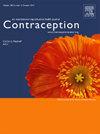Abortion experiences of individuals with a history of trauma(s): A qualitative study
IF 2.3
2区 医学
Q1 OBSTETRICS & GYNECOLOGY
引用次数: 0
Abstract
Objective
Individual trauma is highly prevalent among reproductive age individuals who can become pregnant. We sought to elicit perspectives of individuals with a history of trauma about their abortion experiences, trauma-activating factors in abortion care, and how to optimally incorporate trauma-responsive principles into abortion care.
Study design
Patients with a self-identified history of three types of trauma (sexual assault, interpersonal violence, adverse childhood experience) were recruited from family planning clinics in the Chicago-area to participate in semi-structured phone interviews. Qualitative data was analyzed using ATLAS.ti.
Results
Analysis of thirty interviews identified trauma-activating factors and trauma-responsive strategies throughout the abortion experience. Participants reported that, pre-abortion, restricted access and limited options activated trauma-related feelings of autonomy loss and a desire for unbiased information. During procedures, participants described how physical pain/discomfort and healthcare professional use of insensitive language worsened their experience. In contrast, use of neutral language, warnings prior to touch, proper draping, and checking-in and offering options helped mitigate effects of prior history of trauma(s). Post-procedurally, participants desired mental health support specifically addressing abortion-related stigma, though this resource was rarely available.
Conclusions
Throughout abortion care, numerous opportunities exist to help activate or mitigate trauma responses among individuals with a history of trauma. These opportunities exist at the level of the individual provider as well as the level of the clinic, and must be considered to fully address the needs of individuals seeking abortion who have experienced prior trauma(s).
Implications
Healthcare providers and systems can influence abortion experiences in ways that range from aggravating to ameliorating prior trauma for individuals with prior trauma experience(s). Therefore, trauma-responsive principles must be universally applied throughout abortion care.
有创伤史的个体的流产经历:一项定性研究。
目的:个体创伤在可能怀孕的育龄个体中非常普遍。我们试图引出有创伤史的个体关于流产经历的观点,流产护理中的创伤激活因素,以及如何将创伤反应原则最佳地纳入流产护理。研究设计:从芝加哥地区的计划生育诊所招募自认为有三种创伤(性侵犯、人际暴力、不良童年经历)的患者,参与半结构化的电话访谈。结果:通过对30个访谈的分析,确定了流产过程中的创伤激活因素和创伤反应策略。参与者报告说,堕胎前,受限的访问和有限的选择激活了与创伤相关的自主丧失感和对公正信息的渴望。在治疗过程中,参与者描述了身体疼痛/不适和医疗保健专业人员使用不敏感的语言如何恶化了他们的体验。相比之下,使用中性语言、触摸前警告、适当的包裹、登记和提供选择有助于减轻先前创伤史的影响。手术后,参与者希望得到心理健康支持,特别是解决与堕胎有关的耻辱,尽管这种资源很少得到。结论:在整个流产护理过程中,存在许多机会来帮助减轻或激活有创伤史的个体的创伤反应。这些机会既存在于个人提供者层面,也存在于诊所层面,必须加以考虑,以充分满足经历过先前创伤的寻求堕胎的个人的需求。
本文章由计算机程序翻译,如有差异,请以英文原文为准。
求助全文
约1分钟内获得全文
求助全文
来源期刊

Contraception
医学-妇产科学
CiteScore
4.70
自引率
17.20%
发文量
211
审稿时长
69 days
期刊介绍:
Contraception has an open access mirror journal Contraception: X, sharing the same aims and scope, editorial team, submission system and rigorous peer review.
The journal Contraception wishes to advance reproductive health through the rapid publication of the best and most interesting new scholarship regarding contraception and related fields such as abortion. The journal welcomes manuscripts from investigators working in the laboratory, clinical and social sciences, as well as public health and health professions education.
 求助内容:
求助内容: 应助结果提醒方式:
应助结果提醒方式:


